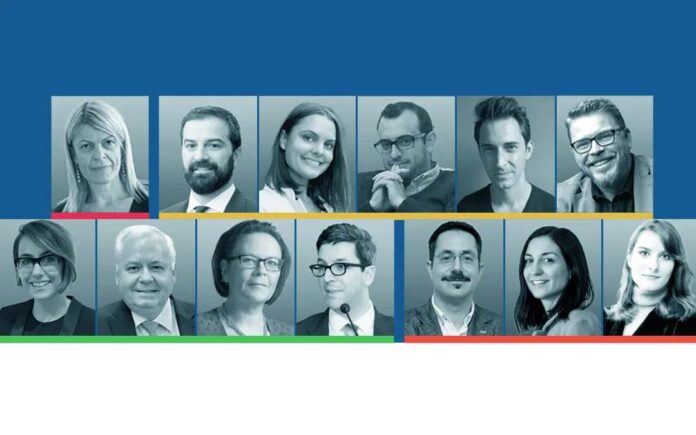With introduction of internet, the world has irreversibly changed, leaving not one stone unturned. The development of digital technologies meant that manner in which we communicate and behave was reshaped, and continues to do so with the introduction of every development in this field. With the appearance of COVID-19, the world has shifted from offline to online space. That meant that everything from concerts, museums, birthday parties to meetings, summits, hearings and plenary sessions was held online. This begs the question, how has digital technology influenced the field of diplomacy, and how will it continue to do so in the time to come. Over several sessions, participants of the XIII Summer School for Young Diplomats had an opportunity to learn and discuss the meaning and future of digital diplomacy.
Digital Diplomacy: Internet as a Factor in Changing Diplomacy
In an inspiring session moderated by Siniša Vuković, senior lecturer at Johns Hopkins University’s School of Advanced International Studies, Sophie Vériter, PhD in the field of Security and Global Affairs at Leiden University, Tristen Naylor, Fellow in International Relations at the London School of Economics and Political Science, Ilan Manor, Digital Diplomacy Scholar at the University of Oxford and Damien Spry, Lecturer in Media and Communication at the University of South Australia, shared nuanced and more niche outlooks on what is nowadays happening in the field of diplomacy.
When it comes to digital diplomacy, scholars tend to focus on technology rather than put diplomats at the centre of their focus. Digital technology, like social media, is used differently from one country to another. As it turns out, Facebook diplomacy works better in the locations that are poorer or with a younger population. Should we wish to understand digital diplomacy, we need to understand the digital society first. We need to question and establish the norms, values and logic that guide digital society, should we want to grasp just how much digital diplomacy has an impact on the citizens of the countries around the world. Once we establish these we can start to understand why diplomats use technology in different ways.
What became clear as we went further into the health crisis caused by the COVID-19 pandemic, is that this crisis will change the digital diplomacy. On one hand, foreign ministries began addressing their audiences online, through social media. While on the other hand, the crisis has taught us that there’s a fine line between public diplomacy and harmful disinformation. And in the case of the EU, this calls for a rethinking of the EU’s ethical consideration and the way it will handle the internal challenges of a public relay.
Hybrid Challenges at the Information Age
The session on Hybrid Challenges at the Information Age began with a kind reminder. Propaganda and disinformation is not something new to us. Rather, these tools have been used in conflicts for centuries. However, what makes it new, is the new and emerging technology. With help of social media and digital platforms, disinformation can do harm faster than it has ever done before by reaching a vast number of people in a very short period of time. Disinformation, however, is just one part of a larger challenge known as hybrid threats.
This session was chaired by Dragana Vešović, Director of Directorate for NATO at the Ministry of Foreign Affairs of Montenegro, while the speakers were Kirsti Narinen, Director of International Relations at the European Centre of Excellence for Countering Hybrid Threats, Michael Rühle, Head of Hybrid Challenges and Energy Security Section at NATO, and James Pamment, Associate Professor and Head of the Department of Strategic Communication at Lund University.
Hybrid threats are composed of military, non-military, traditional, non-traditional, covert and overt methods. They also include anything from cyber-attacks, sabotage, economic pressure, propaganda and disinformation. As such, this type of threat can have serious consequences for targeted states. Hybrid threats can undermine stability, democratic processes, influence elections, exert economic pressure. Even so, they remain just below the threshold of what is traditionally considered warfare. Hybrid threats are difficult to detect, attribute and react to.
The speakers of this panel shared with participants ways in which actors can handle hybrid threats, and build resilience within societies, countries and individuals.
Diplomacy 4.0: The Rise of Digital Tools in Diplomacy
Diplomacy 4.0 session, led by Vladimir Radunović, Cybersecurity and E-diplomacy Programmes Director at DiploFoundation, Nataša Perućica and Katarina Anđelković both researchers at DiploFoundation, introduced several topics that were based on the emerging digital tools and directions which are becoming prominent in the field of diplomacy.
It appears that countries across the world are looking into ways of how they can take advantage of Artificial Intelligence (AI) while mitigating the negative effects that are followed by this emerging technology. Since this type of technology is in the early stage of its usage, many states are aspiring to take the leadership in the field of AI and made this their priority. However, countries are not the only actors interested in further developing and using this technology. Namely, international organisations are taking part too. For example, UNESCO is the most advanced actor when it comes to the ethical usage of AI. Just recently UNESCO established a group/panel of 24 members meant to propose a set of recommendations on ethical challenges posed by AI.
Emerging technologies such as big data, AI, 3D printing, virtual and augmented reality, are all used by countries and international organisations to support their activities in various areas within the scope of their mandate. Which brings us to wonder just how diplomats use digital technologies as a tool for diplomatic practice. There are vast examples of the usage of these tools in diplomacy. The use of virtual reality for diplomatic training is just one example. Often characterised as an empathy machine, virtual reality can allow diplomats to understand and empathise with their counterparts and use the virtual reality technology as an empathy tool.
Science For Diplomacy
Sanja Damjanović, Minister of Science of Montenegro and the chairperson of the SEEIIST Steering Committee, gave an interesting presentation about the research infrastructure for science diplomacy. In her presentation she touched upon how far science reaches when it comes to diplomacy, and how important scientific developments are for the world we live in. The importance of CERN, as the only international organisation that has been granted the observer status in the UN General Assembly in 2012, is undeniable. Global Research projects show what mankind is able to achieve when working together coherently towards a common goal. CERN has become the key example for Science Diplomacy.
Damjanovic also spoke about the developments on the SESAME, ‘Synchrotron Light for Experimental Science and Applications in the Middle East. Built in Jordan, SESAME unifies 9 member states of different political systems and religions in the Middle East: Bahrain, Cyprus, Egypt, Israel, Iran, Jordan, Pakistan, Palestinian Authority, Turkey. All the member states of the SESAME are peacefully working together contributing towards discoveries in the scientific field.
In addition to the two institutions, the participants could hear about plans for SEEIIST, the South East European International Institute for Sustainable Technologies, as yet another concrete example of Science Diplomacy. SEEIST is based on hadronic cancer therapy and research in biomedicine, and shows a strong pan-European character and is not only a benefit for our region but for the whole Europe.
“Global Research projects show what mankind is able to achieve when working together coherently towards a common goal”
The Future of Digital Diplomacy
Technological advancements have certainly made our lives more convenient. This has especially come to a spotlife with the outbreak of the COVID-19 pandemic. And while we are still adjusting to the changes introduced by the technology in the diplomatic sphere, one thing is certain – digital diplomacy is here to stay. Going forward, we are to find ways in which we can combat the negative aspects of the virtual world such as the appearance and the fast spreading of disinformation, hybrid threats and more. However, we are to remind ourselves that with technological advances, we are able to both progress and come closer together at a much faster pace than ever before.
Digital Diplomacy: The Road to Future or an Interim Measure?













